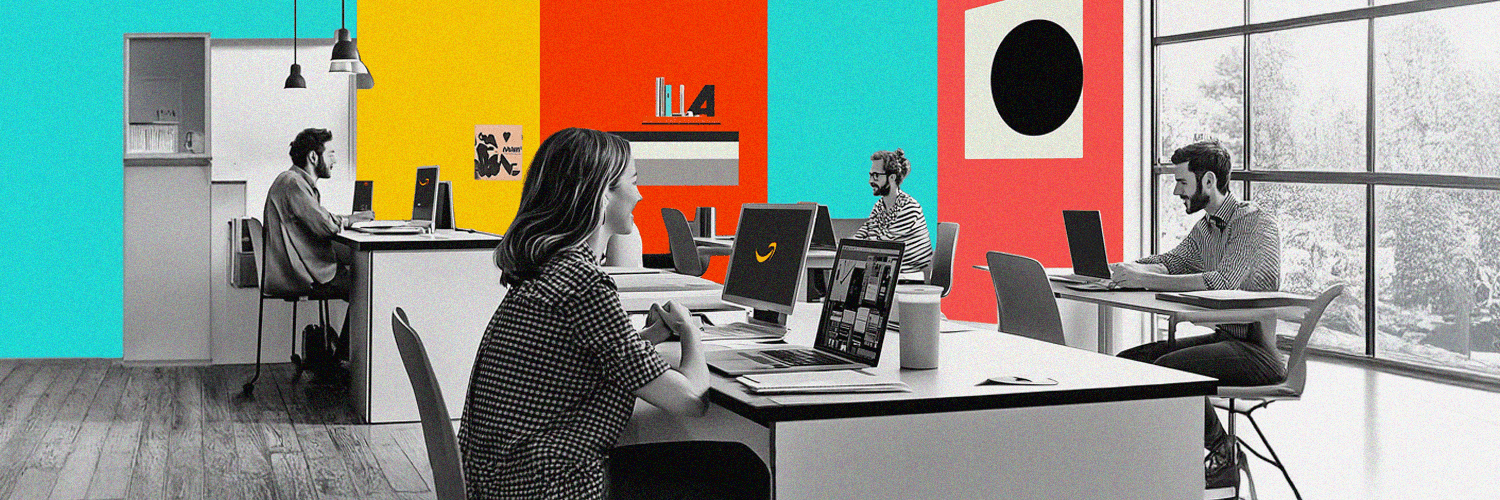In recent years, how we work has changed a lot. Many employees now work from home, and many employees prefer remote working because it can contribute to a healthy work-life balance. But even though lots of people like working remotely, there’s a growing idea that going back to offices could have benefits we haven’t paid enough attention to.
Let's look into these aspects and explore the idea of working in the office and its hidden advantages. This exploration doesn't mean diminishing the appeal of flexible, home-based work. Instead, it's about discovering aspects that could lead to unexpected professional growth when working in the office. Read on!

TL;DR:
-
The debate between working in the office and fully remote work is ongoing, with advocates on both sides highlighting different benefits.
-
Working in the office fosters collaboration, creative synergy, and diverse inputs through spontaneous social interactions and proximity.
-
In-person work simplifies communication, promotes teamwork, and allows for immediate problem-solving, enhancing overall efficiency.
-
Networking opportunities, mentorship, and relationship-building are facilitated in the office environment, contributing to good organizational culture and professional growth.
-
Office space provide immediate access to resources, specialized equipment, and efficient technology infrastructure.
-
Working on site aids in maintaining a clear separation between work and personal life, allowing employees enhance their focus and work-life balance.
-
In-person work contributes to a defined structure, clear communication, and professional development opportunities.
-
The traditional office environment cultivates strong company culture, a sense of belonging, exposure to diverse perspectives, continuous idea sharing, and opportunities for career advancement.
-
The choice between working in the office and home working depends on individual preferences, diverse needs, job roles, and corporate culture.
-
Both models offer unique experiences, with a balanced approach, such as hybrid work, being an optimal solution for harnessing the benefits of both environments.
The Big Debate About Office Working
The big debate about working in the office continues to captivate employers and employees alike. On the one hand, proponents of the traditional office environment argue that it fosters collaboration, team spirit, and a clear separation between work and personal life. On the other hand, advocates for remote work champion the flexibility and autonomy it offers, allowing employees to balance their professional and personal responsibilities better, despite the challenges such as the blurring of work-life boundaries and feelings of isolation.
In this article, we’ll see how different choices affect teamwork, resource access, work-life balance, communication, company culture, and personal growth. We’ll explore why some employees prefer returning to the office despite the appeal of remote work, emphasizing the importance of in person interactions for career development and team bonding.
Finding the right balance involves looking at both the practical advantages and disadvantages of working from home and understanding the bigger picture where career development intersects with personal well-being. It's about creating a complete picture beyond just convenience or discomfort.

Working in the Office Environment Increases Collaboration and Social Interaction
There's something special about the shared energy bouncing off the walls of an office. An in-person work environment opens doors to a world of collaboration that's hard to replicate virtually.
Increased Collaboration Opportunities
Effective collaboration flourishes in close-knit environments. Consider a scenario where you are engaged in a discussion at your desk, and suddenly, a spontaneous brainstorming session ensues. This organic exchange doesn't arise from scheduled meetings but from the proximity and regular, informal interactions between colleagues that occur throughout the day.
Here are some benefits of such interactions:
- Quick problem-solving: When questions arise, your colleague is just a swivel of the chair away.
- Creative synergy: Group dynamics encourage innovative thinking as you naturally build on each other's ideas.
- Diverse inputs: Different departments mingling in common areas bring fresh perspectives.
Working in person creates a fertile environment for collective creativity, often leading to breakthroughs that might be hard to achieve if everyone is isolated behind screens miles apart.
Facilitated Communication and Teamwork
When discussing the benefits of in-person work, we must emphasize how in-person meetings simplify communication. Face-to-face interaction eliminates much of the ambiguity that plagues text-based conversations; nuances like tone and body language enrich our understanding. But that’s not it. Working in the office also brings:
- Clarity: In-person discussions minimize misunderstandings versus reading tone into emails or messages.
- Rapport: Sharing physical space builds camaraderie—an essential ingredient for seamless teamwork.
- Speed: Conversations happen on the fly without waiting for email responses or video call setups.
Thus, working side by side encourages a symphony-like synchrony where each member plays their part cohesively—the epitome of orchestrated team spirit.
Building Relationships and Networking
Now let’s talk networking—integral for professional growth and essential to enhance career growth, but sorely lacking outside the confines of an office setting. An unexpected elevator chat with a senior executive or a lunchroom introduction could evolve into mentorship or job opportunities later. Also, it helps people develop:
- Stronger Bonds: Nuanced interactions create deeper connections beyond what screens' pixels convey.
- Wider Circle: Being physically present allows you to meet stakeholders across various organizational levels and functions.
- Mentorship Opportunities: Senior colleagues often become willing mentors when they get to know you personally—a rare privilege when you're remote.
Those chance encounters beside coffee machines aren't just for grabbing a cuppa—they're potential pivotal moments for fostering enduring relationships vital for career progression.
Working in the Office Facilitates Access to Resources and Infrastructure
Working in office settings is also about the immediate access to resources and infrastructure that a well-designed office setup provides, which simply can’t be replicated at home.
Access to Necessary Tools and Equipment
When working at an office, you never have to worry about whether you have the right tools for a particular job—they are all within arm's reach, including:
- High-performance computers tailored for specific tasks
- Professional printing and scanning facilities
- Specialized software
- Ergonomic furniture which can decrease the likelihood of work-related discomfort or injury
This convenience allows employees working in the office to perform and excel with premium-grade equipment at their fingertips.
Efficient Use of Technology
Being part of an office working environment means more than having good Wi-Fi. The robust tech infrastructure often includes networked systems allowing seamless collaboration, secure servers ensuring data protection, and sophisticated backup solutions guarding against loss of valuable information. In-person IT support is also readily available—no lengthy phone calls or emails waiting for assistance from afar. Hire or train an IT support specialist to contribute directly to the efficiency and functionality of these technological ecosystems.
Moreover, while many gadgets in today's age purport to bring efficiency to our personal lives, those adopted within workspaces usually pack a more powerful punch: video conferencing tools optimized for group presentations or efficient project management software reduce friction between tasks. This all amounts to streamlined workflows where technology elevates productivity rather than impeding it.

Working in the Office Promotes a Healthy Work-Life Balance
The home office provides comfort but lacks healthy and distinct boundaries between work hours and personal time. Let’s dive into how working in the office improves your ability to separate professional responsibilities from personal leisure and refocuses your attention on tasks.
Separation of Work and Personal Life
When you step into your office building, an immediate switch flips inside your mind—signaling that it’s ‘go-time’ for productivity and promoting a healthy work-life balance. This physical transition from home to office lays down clear boundary lines; You know distinctly when you are “off the clock” instead of just being at home but still “on duty.” Here are some pivotal ways in which working at the office aids this separation:
- Rituals of Commuting: Commuting creates a buffer zone between home life and work life. It allows one to mentally prepare for the day ahead or unwind before returning home.
- Dedicated Workspace: Sitting at your designated desk, you draw a bold line under what constitutes workspace versus living space.
- Scheduling Norms: Office hours typically enforce set start and end times, encouraging adherence to a structured routine absent in remote settings.
These elements collectively foster an environment where you can be wholly present in either mode—professional or personal—without carrying the weight of one into the other.
Enhanced Focus on Work Tasks
Concentration is paramount for achieving high-quality output yet is easily fractured by homely distractions. Working from office advantages include being immersed within an ecosystem tailored to optimize task efficiency.
The benefits of working in-office vs home aren't solely about physical presence; they're deeply psychological, too. Consider these aspects:
- Stimulating Environment: Offices are buzzing hives designed to maximize workflow; their atmosphere promotes sustained focus on tasks.
- Immediate Support: Questions answered on the fly without awaiting email replies streamline problem-solving and preserve momentum.
- Purposeful Breaks: Unlike pacing aimlessly at home, breaks taken among colleagues can rejuvenate—as simple camaraderie can reignite waning focus.
Thus, it becomes evident that while flexibility offered by remote jobs is enticing, working in the office cultivates sharper segmentation between our professional endeavors and our cherished leisure time.

Working in the Office Promotes Clear Communication and Defined Structure
In today's hybrid work landscape, the benefits of working in person can sometimes be overlooked. Let's pull back the curtain on how office working fosters clear communication and helps establish a defined structure that can be pivotal for professional growth.
Instant Feedback and Clarification
Working from the office has distinct advantages when it comes to communication dynamics. There's a richness to real-time conversations that isn't as robust through digital channels. An immediate response or quick clarification is just a desk away, reducing misunderstandings and boosting productivity.
- Face-to-face interactions: Rapid exchanges of ideas happen naturally when you're physically around colleagues.
- Non-verbal Cues: Picking up on body language strengthens understanding, often absent in written or virtual communication.
- Swift Problem-Solving: Quick huddles to address urgent issues enable faster resolutions than scheduling virtual meetings might allow.
Behind every interaction lies the opportunity for instant feedback – an essential component in refining skills and adapting strategies on the fly.
Professional Development Opportunities
Office working uniquely positions individuals for career advancement by exposing them continually to new challenges and learning environments. The advantages of working from an office include:
- Exposure to diverse thoughts during casual or formal interactions.
- A sense of being 'in the loop,' with access to critical discussions and decisions.
- Mentorship chances as seasoned professionals are usually more accessible.
When weighed against remote setups, this proximity creates a setting ripe for growth. The benefits of working in person encompass absorbing best practices from peers directly, matching names with faces in high-stakes scenarios, and displaying commitment that resonates well with leadership – all fundamentally contributing to one's career trajectory.
By collaborating closely with coworkers and management, you solidify your role within an organization while carving out paths for future progress. In essence, office work becomes more than a job; it evolves into an active learning hub where personal development is interwoven daily into each task.

Working in the Office Enables Company Culture and Professional Growth
The traditional office environment has been scrutinized, but it's hard to dismiss its significant influence on cultivating a solid company culture and fostering personal development.
Sense of Belonging
When you go to the office, there's a palpable energy that remote work can't replicate. This vibration is born out of daily interactions and shared experiences with coworkers, culminating in a powerful sense of belonging. Here are some reasons why:
- Interpersonal Connections: A smile from a colleague or a quick chat at the coffee machine can set a positive tone for our days.
- Community Involvement: Participating in company events and contributing to joint initiatives leads to meaningful engagement with our team.
- Shared Mission: Aligning with your peers under a single goal fosters unity, creating a work environment where we feel part of something bigger than ourselves.
These aspects contribute significantly to feeling connected at work and engender loyalty and job satisfaction, ultimately enhancing performance and retention.
Exposure to Different Perspectives
One potent benefit of in-person work is exposure to diverse opinions and approaches. These aren't just idle chit-chat; they're pivotal moments where learning takes center stage. Here’s why:
- Learning via Osmosis: By working closely with others in an office, you pick up new skills almost subconsciously through observation and informal interaction.
- Spark Creative Thought: Cross-departmental mingling often leads to innovative ideas as differing viewpoints collide to spark creativity.
- Cultural Awareness: Regular exposure to colleagues from varied backgrounds broadens your outlook - personally and professionally.
This melting pot effect is incredibly enriching; by actively engaging with unique perspectives, you grow in tolerance and acquire invaluable insights for navigating today's modern workplace.
Opportunities for Career Advancements
Working within the palpable dynamics of an office environment offers clear pathways for career progression and promoting key talent. The benefits here are multifaceted:
- Visibility: Your hard work is more evident when leadership sees you in action, potentially leading to promotions and recognition.
- Mentorship Access: Being physically present allows easier access to mentors who can guide your professional trajectory.
- Structured Development Programs: Many organizations prioritize face-to-face training for their employees' growth thanks to better engagement metrics than remote sessions.
Together, these factors equate to distinct advantages for those considering their long-term ambitions within a company setting - sometimes, what propels us forward isn't simply what we do; it’s also about where we choose to do it.

How Workplace Managers Can Create a Great In-Office Experience
The shift in the work environment often brings with it a reimagining of routine practices. Workplace managers grapple with strategies to enhance productivity and employee satisfaction as more employees enter the office. This focus on crafting an exceptional office experience is not just about aesthetics; it's about fostering an environment that genuinely supports the workflow and well-being of those who inhabit it daily.
Optimize Office Layout for Productivity
An optimized office layout can be a game-changer in terms of productivity. Imagine walking into a space that intuitively guides you towards collaboration zones, quiet workstations, and resource hubs—all positioned to reduce distraction and improve focus. Here's how managers can leverage layout design:
- Zoning: Create activity-based workspaces - for instance, lounge spaces for casual meetings and isolated pods for deep work.
- Flexibility: Incorporate adjustable desks and movable partitions to accommodate various tasks and team sizes.
- Ergonomics: Prioritize comfortable furniture that promotes good posture to keep energy levels high throughout the day.
Establish Effective Hot Desking Policies
Hot desking can maximize space usage while instilling a dynamic vibe within the workplace, but it may lead to confusion or conflict without proper policies. To harness its full potential:
- Define clear hot desking guidelines that everyone understands.
- Rotate assigned desks periodically to introduce variety and fairness.
- Utilize technology like YAROOMS desk booking software to ensure seamless desk reservation.
Effective hot desking policies result in balanced office space utilization and offer the flexibility prized in today's hybrid working culture.
Ensure Efficient Hybrid Work Scheduling
Navigating hybrid environments requires astute planning; efficiency comes from coherence in scheduling both remote and in-office work.
A well-designed hybrid work schedule optimizes productivity by allowing employees to harness the advantages of both environments, leveraging the focused, individual work facilitated by remote settings and the collaborative, spontaneous interactions fostered in the office. By embracing flexibility and thoughtful scheduling, organizations can cultivate a work culture that adapts to the evolving demands of the workforce, ultimately fostering a more resilient and harmonious work environment.
The practical aspect of YAROOMS hybrid work calendar shines here by providing:
- A platform where team members can visualize each other's hybrid work schedules.
- Real-time updates on availability, avoiding double bookings or schedule conflicts.
Such technological support helps streamline operations, preventing bottlenecks in managing modern workplaces.
Provide Access to Office Amenities
A well-equipped workplace reflects an appreciation for the workforce and enhances comfort, directly impacting productivity. Essential office amenities like high-speed internet, ergonomic seating, quality coffee machines, and fitness centers signal employers care more than job performance, fostering stronger loyalty bonds.
Quality refreshment stations featuring appealing coffee machines help reenergize staff, while health and wellness facilities, such as onsite gyms, encourage physical activity. Providing these amenities creates an inviting office atmosphere. It highlights the workplace advantages that attract and retain top talent. Investing in such measures significantly improves corporate branding effectiveness and is worthwhile.
Provide Opportunities for Collaboration and Teamwork
Providing opportunities for collaboration and teamwork is paramount for fostering a thriving in-office experience, especially considering the impact of remote workers on energy consumption and the financial implications of working from home during the cost-of-living crisis. Employees can synergize their skills, knowledge, and perspectives in a collaborative environment, leading to more innovative problem-solving and creative imagination. The exchange of ideas and collective effort enhances the overall quality of work and contributes to a sense of shared accomplishment.
Furthermore, collaborative experiences in the office nurture a strong sense of camaraderie and build interpersonal relationships among team members, creating a positive and supportive workplace culture. This interconnection boosts employee morale and establishes a foundation for effective communication and seamless coordination, ultimately contributing to a more cohesive and productive work environment.
Conclusion: Is Working in the Office Better Than Remote Work?
Deciding whether working from the office or remotely is better involves considering individual preferences, job roles, and corporate culture. Working in an office presents structured benefits, including immediate feedback, professional development through direct supervision, and increased visibility for career growth. Office environments often foster collaboration through brainstorming sessions, which can spark unique, game-changing ideas and enhance decision-making. Additionally, the social aspects of shared spaces help build social capital, an element often harder to cultivate in remote settings.
On the other hand, remote work provides flexibility and a quiet environment that can increase efficiency for many workers. However, it can challenge work-life boundaries unless individuals set healthy habits to reduce stress and maintain balance. For those who physically leave the workplace at the end of the day, the separation between work and home life can feel more genuine, reducing the likelihood of longer hours extending into personal time.
Neither model wins outright; both offer unique experiences tailored to various needs and preferences. The growing adoption of hybrid work models is a clear sign of the evolving workplace. These models blend the flexibility of remote work with the undeniable synergy of shared spaces, enabling businesses to implement activities that build community while accommodating the vast majority of employees' preferences. By navigating this balance thoughtfully, organizations and individuals can create environments that foster productivity and innovation to a greater extent.












